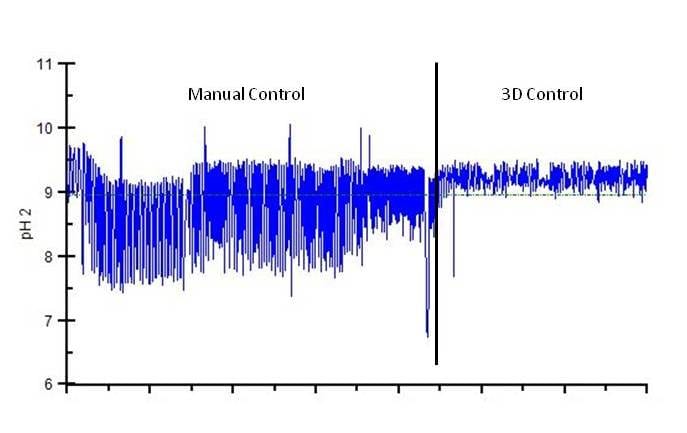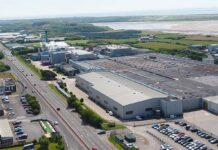A TW report by Steve Hoefs, senior industry development manager, Nalco, an Ecolab company.
Reliable Yankee dryer performance is a key contributor to the smooth operation and finished product quality of every tissue machine. Continuous delivery of a high quality steam supply and an efficient condensate removal system is necessary to maintain consistent dryer performance. When Yankee dryer performance declines, the tissue machine may experience reduced drying capacity, increased pressure drop, wet streaks and random coating patchiness. When these symptoms become apparent, it is too late. Quality and production have already been adversely affected.
To maintain Yankee dryer system performance, the tissue manufacturer must have a comprehensive steam/ condensate control strategy in place that takes into consideration the following elements: condensate chemistry, corrosion/deposit control and system monitoring. This article reviews how 3D TRASAR technology for Yankee dryer systems from Nalco meets these needs, ensuring that the appropriate system protection is in place at all times in response to the dynamic nature of the Yankee dryer steam/condensate system.
‘Systems operating with varied boiler feed water make-up rates and alkalinity levels will generate inconsistent carbonic acid levels.’
STEAM/CONDENSATE CHEMISTRY: SOURCES AND EFFECT OF ALKALINITY AND OXYGEN
The boiler pretreatment system has a direct effect on the amount of carbonic acid and oxygen that can enter the Yankee dryer system and negatively affect its performance. In sodium zeolite softened water systems all of the raw water alkalinity present in the make-up water source is allowed to enter into the boiler feedwater system. Under boiler water temperature and pressure conditions the alkalinity breaks down and carbon dioxide gas is generated. The reaction is shown in Figure 1.
The carbon dioxide gas travels out with the steam and possesses no cause for operational concern until the steam is condensed to its liquid form. At that point, the condensing water reacts with the CO2 gas forming carbonic acid, which equilibrates in solution as shown by the reaction in Figure 2.
Systems operating with varied boiler feed water make-up rates and alkalinity levels will generate inconsistent carbonic acid levels in the return condensate system and, if not continuously monitored and adjusted for, will produce periods of depressed condensate pH and a more corrosive environment within the return condensate system including the Yankee dryer.
Alkalinity levels in the boiler feedwater can be reduced through enhancements to the boiler pretreatment equipment. In most tissue mills, which operate with low pressure package boiler systems, the boiler feedwater make-up system is typically based around sodium zeolite softeners alone. As mills have been expanding their boiler pretreatment systems through the addition of
reverse osmosis trains to the pretreatment strategy, they have been able to reduce their make-up water alkalinity levels by up to 95%.
Another element that must be considered within the pretreatment and return condensate system is
dissolved oxygen. Oxygen can enter the Yankee dryer through ineffective operation of the feedwater deareator or air in-leakage from vacuum seals. When both carbon dioxide and oxygen are present, the resulting corrosion rate is 10 to 40 times greater than the 49 sum of the corrosion rates of the two gases acting separately.
CORROSION/DEPOSIT CONTROL:
Yankee dryer performance is directly related to the effective removal of condensed steam from within the dryer. A common Yankee dryer condensate removal design utilises “soda straws” to evacuate the condensed steam. If flow through these straws is restricted, condensate can build up within the dryer causing inefficient operation. The most common cause of soda straw flow restriction is plugging of the straw orifice with accumulated iron. The sources of the iron creating these deposits can be from the formation of active corrosion by-products within the dryer system or by the rapid release of the passive magnetite layer which forms on the drum wall and internals. Both of these events can occur when a corrosive atmosphere is present within the Yankee dryer system.
To minimise soda straw plugging, it is critical to maintain a proper balance between the chemical treatment programme and the level of carbonic acid and oxygen present within the condensate stream and the chemical treatment programme used to neutralise/scavenge these elements. Because of the dynamic nature of the tissue machine operation (grade changes, breaks, etc), this balance is continuously shifting, thereby making it difficult to maintain a non-corrosive atmosphere.
[box]
CASE STUDY 1
A US mid-western tissue mill had experienced Yankee dryer soda straw plugging concerns. As a result of these concerns, the mill established a satellite condensate treatment application ahead of the Yankee dryer system. Prior to the 3D TRASAR automation of the satellite condensate treatment, the programme was adjusted by operations staff based upon the pH of a grab sample taken off the Yankee flash tank. The pH control range that the operators were targeting was 8.8 to 9.2 based on the metallurgies in the Yankee dryer and soluble iron wet tests that showed 0 ppb iron levels when operating within this control range.
Figure 3 demonstrates the performance improvement results from using 3D TRASAR technology for Yankee dryer systems. The first portion of the graph shows when the 3D TRASAR system was in monitoring mode only. This initial evaluation established the operating benchmark for manual control in maintaining the desired pH control range. In operator control, the Yankee dryer system was experiencing regular pH swings from 7.5 to 9.5.
The second half of the graph shows when the 3D TRASAR for Yankee dryer systems was placed in control mode. The 3D TRASAR controller was able to maintain Yankee dryer pH between the desired control limits, 8.8 to 9.2 on a consistent basis. Based upon these results, the mill is proceeding with additional enhancements to the satellite chemical feed system to provide additional tightening of this control band.

[/box]
MONITORING:
Because of the variability in boiler pre-treatment system and tissue machine operation, it is imperative that a monitoring and chemical control programme be established that maintains a non-corrosive atmosphere within the Yankee dryer and return condensate system at all times.
Tissue manufacturers have used a variety of techniques, as seen in Table 1, to monitor the performance of their Yankee dryer steam /condensate systems.
None of the tests listed in Table 1 provide a direct indication of the atmosphere present within the return condensate in the Yankee dryer. All of these techniques use indirect measurements in an attempt to quantify the corrosive nature of the Yankee condensate and to provide assurance that the appropriate chemical treatment programme is being applied in response to the changing operational conditions.
Through the use of 3D TRASAR technology, we have seen that these practices alone are insufficient in maintaining consistent system protection of the Yankee dryer system.
‘To minimise soda straw plugging, it is critical to maintain the proper balance between the level of carbonic acid and oxygen.’
3D TRASAR TECHNOLOGY FOR YANKEE DRYER SYSTEMS:
Understanding the dynamic operation of the Yankee dryer system, 3D TRASAR technology for Yankee dryer systems from Nalco was developed to continuously monitor and control those critical parameters associated with maintaining optimal dryer steam/ condensate performance. The level of responsiveness achieved through this technology minimises system upsets and limits the production of corrosion by-products and soda straw deposit formation within the Yankee dryer.
This technology provides:
- Minimised corrosion in the Yankee dryer. A critical component of the 3D TRASAR Yankee dryer technology is Nalco’s innovative way of directly monitoring the corrosive nature of the return condensate stream through the patented Nalco Corrosion Stress Monitor™ (NCSM). The NCSM
was developed to measure the oxidation reduction potential of hot water systems at system
temperatures and pressures. Combining the NCSM data with system pH monitors the corrosion
potential of the condensate in the Yankee dryer system as opposed to the bulk condensate. The 3D TRASAR technology collects these system measurements along with other Yankee dryer data (steam flow, dryer pressure, etc.) and utilises this information to proportionally control a
supplemental chemical treatment programme necessary to minimise the corrosion potential within the Yankee dryer condensate. When combining the NCSM readings with Fe+2, soluble iron, wet lab
testing, an optimal control range is able to be determined for the Yankee dryer. Once this range is determined, the 3D TRASAR technology will continuously monitor and re-adjust the
chemical treatment programme to maintain system control within the specified range. - 24/7 monitoring and alarming of the Yankee dryer operational conditions and condensate system to quickly respond to system upsets and provide diagnostic support.
- Real-time analysis of the effect of Mechanical, Operational and Chemical (MOC) changes in the steam production and Yankee dryer condensate systems, reducing the production of corrosion by-products.
The case studies highlight the results obtained using 3D TRASAR technology for Yankee dryer systems as part of Nalco’s comprehensive plan to improve overall machine performance.
SUMMARY
Reliable Yankee dryer performance is a key contributor to the smooth operation of every tissue machine. Through application of 3D TRASAR technology for Yankee dryer systems from Nalco, tissue manufacturers are able to protect the internal surfaces of this vital mill asset by monitoring/ controlling critical parameters within the Yankee dryer condensate system assuring the dryer’s performance.
[box]
CASE STUDY 2
A US tissue mill had experienced a prolonged period of inconsistent Yankee dryer operation resulting in several unscheduled outages to clear plugged soda straws. The mill monitored and controlled their condensate treatment programme based upon grab samples taken from the main condensate receiver in the powerhouse. Utilising 3D TRASAR technology for Yankee dryer systems, Nalco was able to monitor the inconsistency in Yankee dryer protection that this control strategy was providing. Figure 4 highlights the required treatment programme adjustments that were required by the 3D TRASAR system to maintain proper system control in response to the dynamic nature of the steam/ condensate system supplying the Yankee dryer.

[/box]
3D TRASAR, Nalco Corrosion Stress Monitor, Ecolab, Nalco and the logos are trademarks of Ecolab USA Inc.
©2013 Ecolab USA Inc. All Rights Reserved.





























